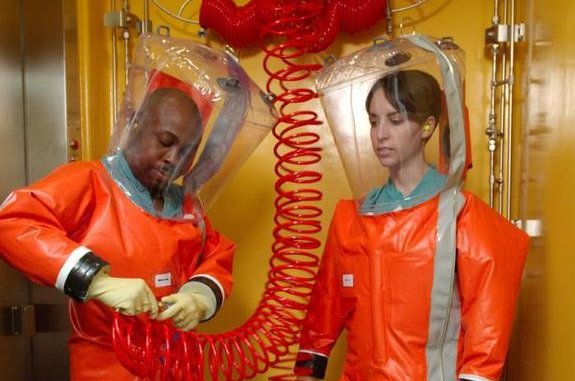Centers for Disease Control microbiologists don advanced protective suits. (CDC)
WASHINGTON, Oct. 30 (UPI) -- It's well known that scientists at NASA are eager to get samples of soil and rock from Mars into labs here on Earth. And and the most coveted of samples are those that might contain evidence of life, microbial or otherwise.
But what are the dangers of such samples? Could Martian bacteria become a public health menace? Could alien organisms become environmental hazards? Yes and no, experts say.
In a recent interview with Space.com, biologist John Rummel, a professor at East Carolina University, said: "The Ebola situation bears no resemblance to a sample-return mission to Mars."
But that doesn't mean, Rummel pointed out, that the public couldn't or wouldn't make the unwarranted connection out of fear or lack of information. And as such, scientists at NASA and elsewhere can take clues from the ongoing Ebola epidemic.
The key takeaway of the Ebola outbreak and the ongoing response by the medical and scientific community, says Rummel and others, is the need on the part of professionals to remain cautious and diligent in their adherence to safety protocols.
"Even more important than the containment facility in which the testing will be done is the fact that scientists will 'practice, practice, practice' to ensure that the sample is contained until shown to be safe for release," Rummel said.
Catharine Conley, a NASA scientist whose official title is Planetary Protection Officer, said the recent outbreak highlights "the need to have good protocols in place prior to bringing potentially hazardous materials back to Earth, and having a very careful and well-tested plan for how to determine that they are 'safe.'"
"Recent events demonstrate how important it is for Earth safety to avoid false negatives, as well as avoiding false positives to protect human activities at Mars," Conley added.
But it's not just NASA taking cues, those on the front lines of the battle against the deadly virus are also taking cues from the U.S. space agency. Health officials have been considering the incorporation of robots and advanced protective suits.
"This is very much inside the government, an interagency effort," John Holdren, the president's top science adviser, recently said in an NPR interview. "NASA knows how to make protective suits that work in extreme environments. We're tapping that expertise, along with others."















